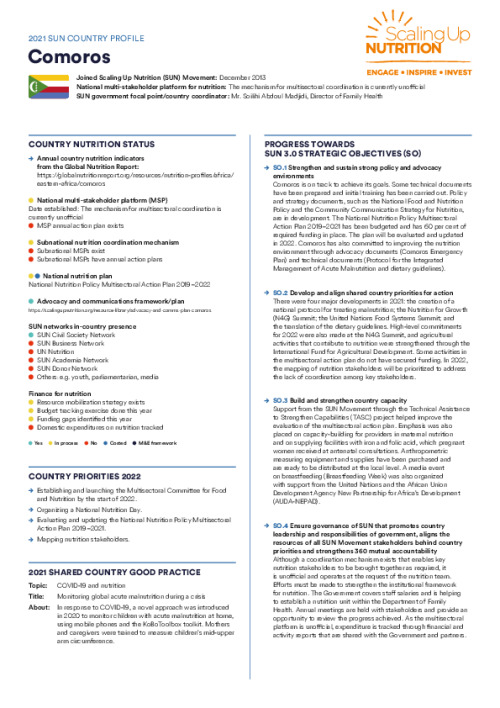
Comoros
Joined Scaling Up Nutrition (SUN) Movement
December 2013
National multi-stakeholder platform for nutrition
A multisectoral coordination mechanism exists, but it is not official
Sun Government Focal Point/Country Coordinator
Dr Soilihi Abdoul Madjidi, Director of Family Health , Ministry of Health, Solidarity, Social Protection, and Gender Promotion
Country nutrition status 2022
- Yes
- In process
- No
- Costed
- M&E framework
National multi-stakeholder platform (MSP)
National nutrition plan
Advocacy and communications framework/plan
Subnational nutrition coordination mechanism
SUN networks in-country presence
Finance for nutrition
Country priorities 2022
Progress towards SUN 3.0 Strategic Objectives (SO)
Fulfilment of the commitments made by the government for the year 2022 at the Tokyo Summit (N4G); strengthening of nutritional care for children suffering from severe acute malnutrition by UNICEF/JICA funds; organisation of a media event on breastfeeding (Breastfeeding Week).
The country has made efforts to improve the nutrition environment by producing advocacy documents (Emerging Comoros Plan) and technical documents (integrated malnutrition management protocol, Comorian food guide). In addition, regular meetings with stakeholders have been organised in order to see the progress made in nutrition, and to focus on nutrition indicators.
Although Comoros has recorded a number of successes, there are still some capacity gaps to be filled, particularly in resource mobilisation. Effective implementation of community nutrition activities
There is a nutrition governance system and structure, but efforts need to be made to improve the institutional framework for nutrition, as well as the recruitment of qualified people within the nutrition department. For the time being, the government is ensuring the payment of the necessary human resources (National Nutrition Manager and his island sponsors) and the establishment of the nutrition service within the Directorate of Family Health. To improve the country's capacity to implement more programmes, a roundtable is planned for 2023 to mobilise funds for nutrition.


